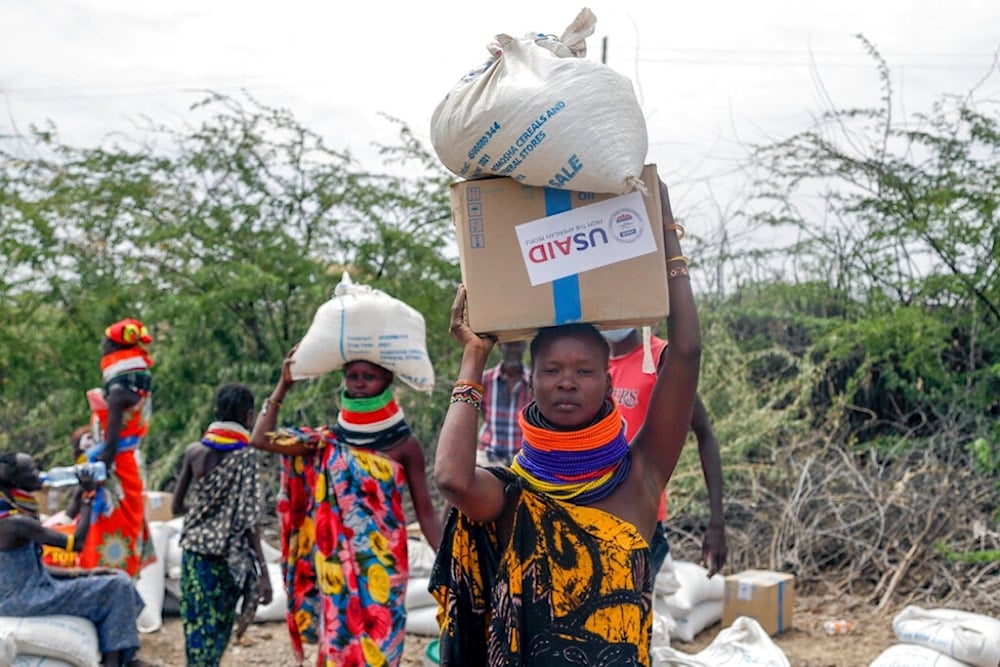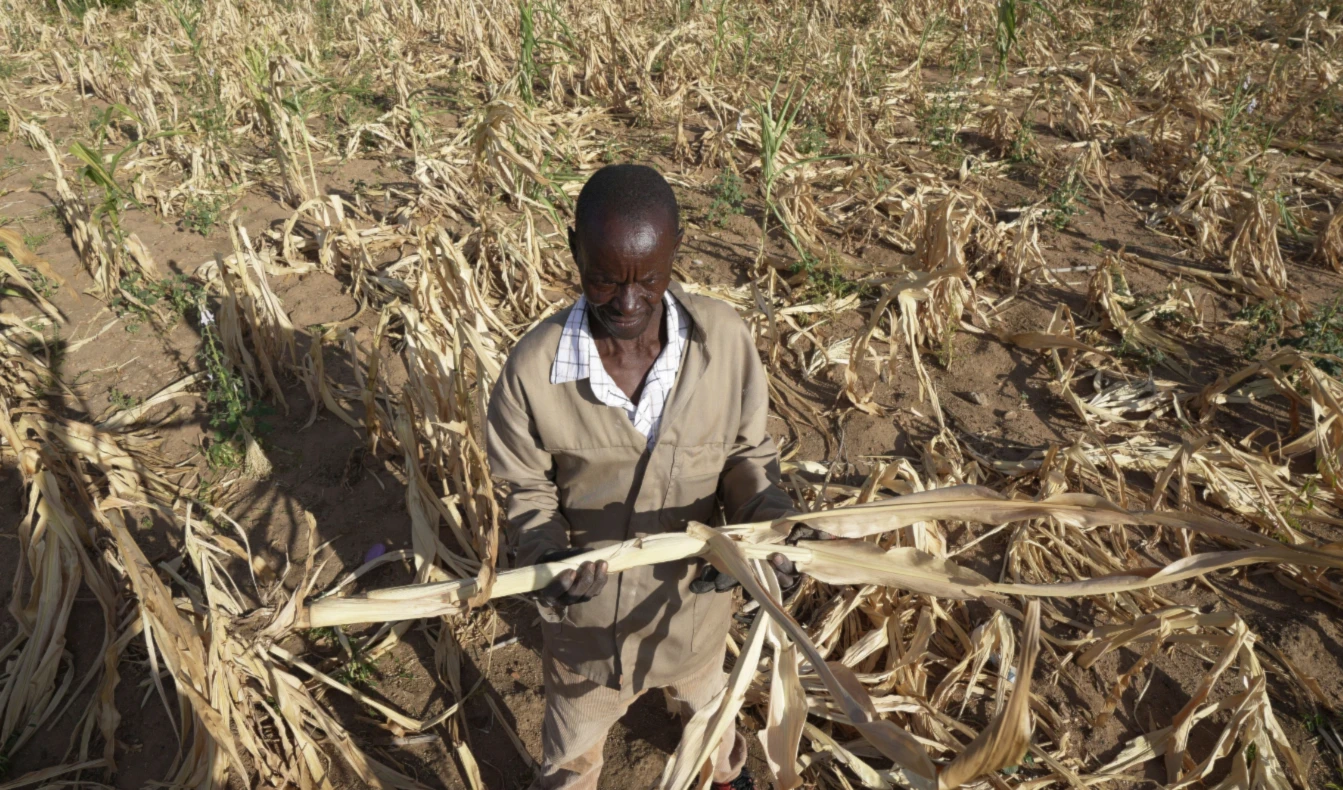Global hunger crisis deepening amid aid cuts and conflict
A worsening global hunger crisis driven by conflict, climate change, and aid cuts is pushing millions into food insecurity, with experts warning that global food security is at risk.
-

Local residents carry boxes and sacks of food distributed by the United States Agency for International Development (USAID), in Kachoda, Turkana area, northern Kenya, Saturday, July 23, 2022. (AP/Desmond Tiro)
In the decades following the Green Revolution, global agricultural productivity surged, raising hopes that food scarcity was becoming a problem of the past. Arif Husain, Chief Economist at the United Nations World Food Program, writes for Foreign Affairs Magazine that today, the UN’s Food and Agriculture Organization (FAO) and the UN Environment Program estimate that the world produces enough food to nourish nearly 10 billion people, far more than the current global population.
However, Husain writes that such a success has bred complacency. A deeper global hunger crisis has taken shape, not due to the lack of food, but from entrenched barriers to access.
The Foreign Affairs contributor cites the FAO’s 2025 State of Food Security and Nutrition in the World report, which shows that up to 720 million people remain chronically food insecure. Among them, 43 million children suffer from wasting, the most severe form of malnutrition, and 152 million endure stunted growth caused by nutritional deficiencies and infections.
Husain also adds that according to the UN World Food Program (WFP), 319 million people currently face acute hunger, an increase of more than 130% compared to levels before 2020. Two ongoing famines, in Gaza and Sudan, underscore how conflict and crisis have overtaken natural scarcity as the leading drivers of hunger.
Read more: ‘They are wasting away’: Gaza’s children face mass starvation
War, debt, and climate strain food access
The Foreign Affairs contributor notes that the structural causes of food insecurity have shifted. While drought once played a central role, Husain writes that hunger today is fueled by war, climate disasters, and economic collapse. The Uppsala Conflict Data Program recorded a rise in global conflicts from 46 in 2014 to 61 in 2024, while the rate at which conflicts are resolved has reached a five-decade low.
Husain writes that the link between conflict and hunger is well established, with nearly 70% of those experiencing acute food insecurity residing in conflict-affected states. In Gaza and Sudan, war has driven one million people into famine.
Climate change has further aggravated the situation. Husain cites the Center for Research on the Epidemiology of Disasters in saying that the annual average of climate-related disasters rose from 231 (1985–2004) to 343 since 2005. In 2024 alone, 371 disasters, ranging from floods to hurricanes, displaced 45 million people. In the Caribbean, Hurricane Melissa left 3.1 million people in need of urgent food aid. Floods in Pakistan affected 6.3 million people. In the Sahel, droughts have intensified poverty and displacement, creating openings for armed groups to manipulate scarcity.
Husain says the economic picture is just as bleak.
Half of low-income countries are in or near debt distress; debt burdens are forcing governments to prioritize repayments over spending on food imports, rural infrastructure, or social safety nets; more than three billion people now live in countries where debt interest payments exceed spending on health or education; food prices have increased by more than 50% in 61 countries and over 100% in 37 others, and he return of protectionist trade measures has further restricted access to essential food supplies.
Hunger fueled by humanitarian aid cuts
Just as global need reaches alarming levels, international support is weakening. Husain writes that after five years of steady growth, global aid declined by 9% in 2024. Projections by the Organization for Economic Cooperation and Development suggest a further fall of 9% to 17% this year.
The WFP, which reached 124 million people in 2024, expects to serve 21% fewer people in 2025. The United States, once the largest donor, has cut its contribution by 55%, with comparable reductions from France, Germany, and the United Kingdom.
Husain adds that some operations are delivering less than 300 calories per person per day, barely a single small meal. Sixteen million people now risk losing all food assistance.
He cites a Lancet study published in July 2025, which projected that the dismantling of the US Agency for International Development (USAID) by the Trump administration could result in up to 14 million premature deaths over five years, many due to hunger.
Aid organizations are not only underfunded, Husain writes, they are also increasingly under attack. In 2024, 383 aid workers were killed, more than double the average of the preceding three years, with the rise reflects the growing disregard for humanitarian law in modern conflict zones.
Read more: WFP warns global aid cuts threaten 13.7 million with hunger
Political neglect with global consequences
The consequences of neglecting the global hunger crisis extend far beyond the communities most directly affected. Husain writes that food insecurity has been linked to displacement, political destabilization, and rising extremism.
Citing a 2017 WFP study, Husain states that each percentage point increase in food insecurity leads to a 1.9% rise in refugee outflows. Moreover, for every additional year that conflict persists, the number of refugees rises by 0.4%.
In 2024, OECD countries spent $24.2 billion on humanitarian aid, reaching 198 million people, about $120 per person. By contrast, these same countries spent $27.8 billion on just three million refugees and asylum seekers, or $9,200 per person. It is significantly more cost-effective to support people before displacement occurs than to manage the aftermath.
Ignoring hunger also increases the risk of violent instability. Husian notes that desperation is weaponized by armed groups, and hunger is used to recruit, control, and terrorize. The link between hunger and conflict is cyclical and self-reinforcing.
Read more: Senegal: Russia economic isolation causing food insecurity in Africa
A strategic and moral imperative
According to Husain, addressing the global hunger crisis requires more than emergency rations; it demands political will, multilateral coordination, and consistent financing. The solution is not technical. It is structural and strategic.
Governments, development institutions, and private donors must restore predictable, multiyear funding for food assistance and resilience-building programs. Agencies such as the FAO, the WFP, and the US Famine Early Warning System must be fully resourced to detect early warning signs and coordinate timely responses.
Violations of international humanitarian law, including the use of hunger as a weapon, must be prosecuted. Targeted sanctions, asset freezes, and travel bans should be deployed against those responsible.
Donors must also overcome institutional fragmentation. Too often, humanitarian, development, and peace-building programs operate in silos. Agencies should coordinate vulnerability assessments, share data, and align with national response plans to eliminate duplication and gaps.
Debt relief mechanisms, such as food-for-education programs implemented by the WFP in Egypt and Mozambique, show how financial tools can be used to alleviate hunger while easing economic pressures.
High-income countries should remove tariffs on imports from food-insecure regions and avoid export bans that destabilize markets. Climate finance must prioritize drought-resilient agriculture, flood defenses, and early warning systems to address the intersection of climate change and hunger.
Food as a foundation for peace
Husain states that global hunger cannot be separated from global security. Governments that claim to champion peace in Ukraine, Gaza, and elsewhere must recognize that no ceasefire can hold without food security.
The Foreign Affairs writer continues to say that hunger not only undermines peace agreements; it prevents recovery. Aid workers must be able to reach populations in need. That requires more investment in negotiations with local authorities, remote delivery tools, digital monitoring, and on-the-ground partnerships.
The world has the tools and knowledge to end extreme hunger. The cost of inaction is far greater, economically, politically, and morally. As Husain concludes in his article “The persistence of hunger is not inevitable. It is a policy choice. Reversing it is not only a moral duty; it is a strategic necessity.”

 8 Min Read
8 Min Read










